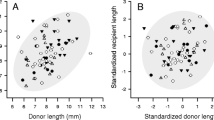Summary
Examples of positive assortative mating by body size are abundant but its causes remain controversial. I show that size-assortative mating occurs in the chrysomelid beetle Trirhabda canadensis and I test a series of alternative hypotheses to explain how this mating pattern comes about. Results suggest that assortative mating in this beetle is due to the greater ease with which size-matched pairs can achieve intromission, and not due to size-biased skews in the availability of mates or mate choice favoring large individuals. There was no correlation between male and female elytron length (a measure of body size) at the initiation of courtship, but pairs assorted positively by size at the onset of intromission. Moreover, in the laboratory, there was a negative correlation between male and female size for pairs engaged in courtship that terminated without mating. Assortative mating was not associated with a large-male mating advantage and there was no evidence of female choice of large males. Nor was there unequivocal evidence for male choice of large females; although mating females were slightly larger and considerably heavier than solitary females, males did not differ in the frequency with which they rejected large and small females. Assortative mating in T. canadensis appeared to be caused by the lower ability of mismatched pairs to achieve intromission after an encounter, both when males were larger and when they were smaller than the female.
Similar content being viewed by others
References
Borgia G (1981) Mate selection in the fly Scatophaga stercoraria: female choice in a male-controlled system. Anim Behav 29:71–80
Brown WD (1990a) Size-assortative mating in the blister beetle Lytta magister (Coleoptera: Meloidae) is due to male and female preferences for larger mates. Anim Behav 40:901–909
Brown WD (1990b) Constraints on size-assortative mating in the blister beetle Tegrodera aloga (Coleoptera: Meloidae). Ethology 86:146–160
Burley N (1983) The meaning of assortative mating. Ethol Sociobiol 4:191–203
Cooke F, Finney GH, Rockwell RF (1976) Assortative mating in lesser snow geese (Anser caerulescens). Behav Genet 6:127–140
Crespi BJ (1989a) Causes of assortative mating in arthropods. Anim Behav 38:980–1000
Crespi BJ (1989b) Sexual selection and assortative mating in subdivided populations of the thrips Elaphrothrips tuberculatus (Insecta: Thysanoptera). Ethology 83:265–278
Elwood RW, Dick JTA (1990) The amorous Gammarus: the relationship between precopula duration and size-assortative mating in G pulex. Anim Behav 39:828–833
Elwood R, Gibson J, Neil S (1987) The amorous Gammarus: size assortative mating in G pulex. Anim Behav 35:1–6
Fairbairn DJ (1988) Sexual selection for homogamy in the Gerridae: an extension of Ridley's comparative approach. Evolution 42:1212–1222
Fisher RA (1918) The correlation between relatives on the supposition of Mendelian inheritance. Trans Roy Soc Edinburgh 52:399–433
Foote CJ, Larkin PA (1988) The role of male choice in the assortative mating of anadromous and nonanadromous sockeye salmon (Oncorrhynchus nerka). Behaviour 106:43–62
Greenwood PJ, Adams J (1984) Sexual dimorphism in Gammarus pulex: the effect of current flow on precopula pair formation. Freshwater Biol 14:203–209
Gwynne DT (1982) Mate selection by female katydids (Orthoptera: Tettigoniidae, Conocephalus nigropleurum). Anim Behav 30:734–738
McCauley DE (1981) Application of the Kence-Bryant model of mating behavior to a natural population of soldier beetles. Am Nat 117:400–402
McLain DK (1982) Behavioral and morphological correlates of male dominance and courtship persistence in the blister beetle Epicauta pennsylvanica. Am Midl Nat 107: 396–403
Parker GA (1982) Phenotype limited evolutionarily stable strategy. In: Bertram BR, Clutton-Brock TH, Dunbar RIM, Rubenstein DI, Wrangham R (eds) Current problems in sociobiology. Cambridge University Press, Cambridge
Pinto JD, Mayor AJ (1986) Size, mating success, and courtship pattern in the Meloidae (Coleoptera). Ann Entomol Soc Am 79:597–604
Price PW, Willson MF (1976) Some consequences for a parasitic herbivore, the milkweed longhorn beetle Tetraopes tetraophthalmus, of a host-shift from Asclepias syriaca to A verticilla. Oecologia 25:331–340
Ridley M (1983) The explanation of organic diversity. The comparative method and adaptations for mating. Clarendon Press, Oxford
Robertson JGM (1990) Female choice increases fertilization success in the Australian frog, Uperoleia laevigata. Anim Behav 39:639–645
Thornhill R, Alcock J (1983) The evolution of insect mating systems. Harvard University Press, Cambridge
Tower WL (1906) An investigation of evolution on chrysomelid beetles of the genus Lepinotarsa (Publication No 48). Carnegie Institution Washington
Ward PI (1988) Sexual selection, natural selection, and body size in Gammarus pulex (Amphipoda). Am Nat 131:348–359
Wright S (1921) Systems of mating. III. Assortative mating based on somatic resemblance. Genetics 6:144–166
Author information
Authors and Affiliations
Rights and permissions
About this article
Cite this article
Brown, W.D. The cause of size-assortative mating in the leaf beetle Trirhabda canadensis (Coleoptera : Chrysomelidae). Behav Ecol Sociobiol 33, 151–157 (1993). https://doi.org/10.1007/BF00216595
Received:
Accepted:
Issue Date:
DOI: https://doi.org/10.1007/BF00216595




